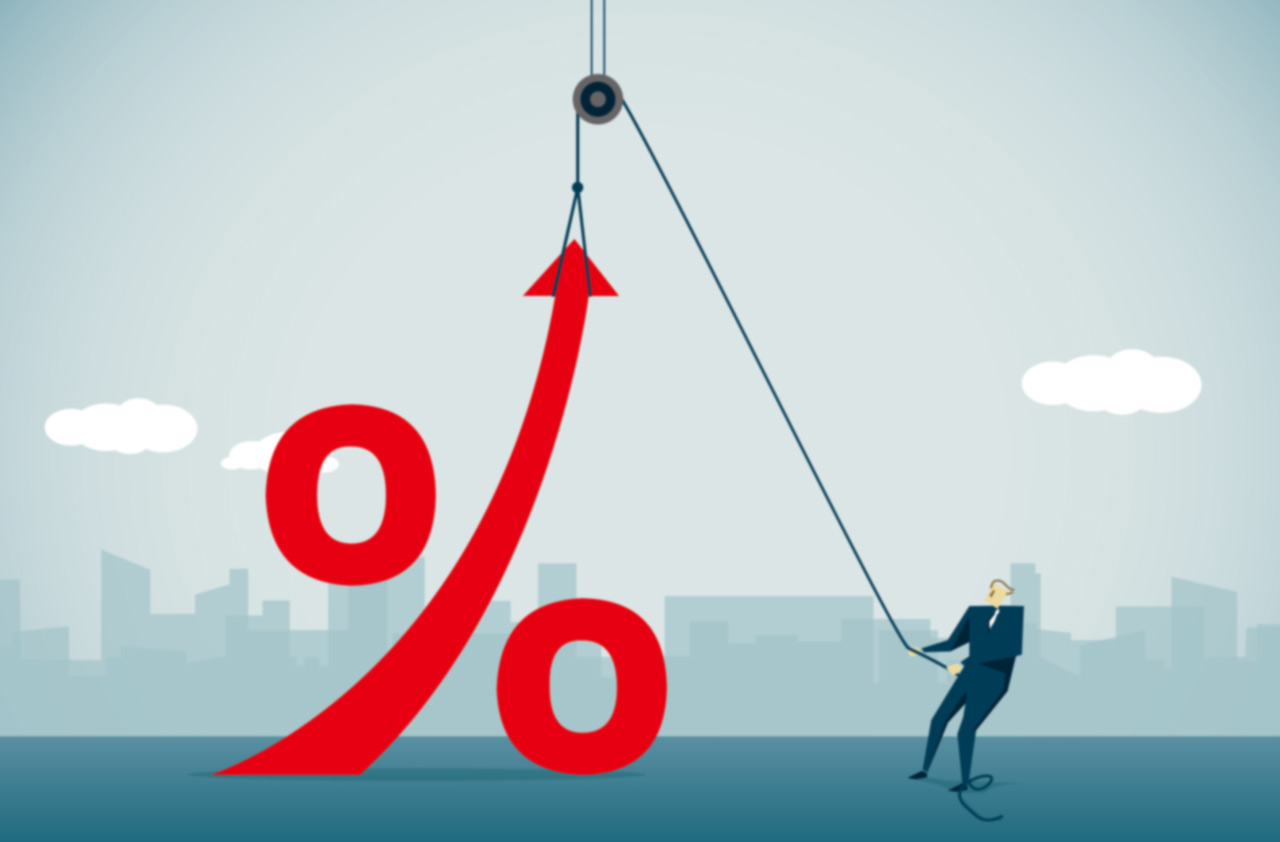Rates Are Rising. Is It Time to Sell Your Bonds?
Conventional wisdom holds that bonds' value falls as rates rise, and rates are rising, so now what? Well, before you start selling, read this.


With interest rates still close to historic lows there has been lots of talk about how rising interest rates will reduce bond values. This hasn’t been helped by President Trump’s trade war threats, which have the potential of causing rising prices and higher inflation.
The Federal Reserve has raised rates six times in the past three years. Even though rates are rising, there are still many reasons to hold bonds. One of the most important is that a portfolio that includes bonds will help investors weather the storms of the stock market and keep them invested, rather than selling when stocks drop. If you don’t stay invested in stocks, it is unlikely that you will keep pace with inflation, which could jeopardize your reaching your financial goals. In fact, if the recent market volatility made you a little jittery, you may actually want to increase your bond exposure now, rather than reduce it.
Making a Case for Bonds
Let’s start by examining the reason you added bonds to your portfolio in the first place. The main reason to buy bonds is to have an asset that hopefully grows faster than cash investments, like bank accounts and money market funds, but doesn’t drop — or at least not as much — as stocks can drop. So, we anticipate that bonds will provide returns somewhere around 4% to 5% over time, which is somewhere between cash, with returns between 1% and 2%, and stocks, historically at 8% to 10%.

Sign up for Kiplinger’s Free E-Newsletters
Profit and prosper with the best of expert advice on investing, taxes, retirement, personal finance and more - straight to your e-mail.
Profit and prosper with the best of expert advice - straight to your e-mail.
If stocks take a turn for the worse, we hope bonds will cushion the fall. Has this been the case? Let’s look back at a couple of past periods and see if this held true — bonds helping a portfolio when stocks fell.
- This was the case in 2008. Stocks, as measured by the S&P 500 index, were down in 2008 (37%), while intermediate Treasury bonds were up 11.35% and international bonds were up 10.11%. Corporate bonds fell, but not by much (2.76%).
- How about in 2002? The S&P 500 index fell (22.09%) while government bonds, corporate bonds and international bonds were up 9.28%, 10.14% and 21.99% respectively.
So, in our last two big market pullbacks bonds would have given your portfolio a boost.
How Have Bonds Performed in Times of Rising Rates?
The Federal Reserve uses the fed funds rate as a tool to control inflation. Let’s look at interest rates and inflation and how they interact with bond values. The question we must answer is, if inflation increases and the Federal Reserve raises rates, what will that do to your bond portfolio? Let’s use one of the worst inflationary periods we’ve ever encountered as our guide. From 1970 to 1980 inflation went from a low of 5.4% to a high of 14.8% as measured by the consumer price index (or 10.99% per year). During this same period the fed funds rate increased from 6.13% to 19.85%. To jog your memory, this is the time when a 30-year mortgage came with a 13.74% interest rate.
While rates were increasing, what happened to bonds? To answer this question, I ran a hypothetical illustration using Morningstar and two bond funds that have been around a long time. I took those two funds — a government bond fund and a corporate bond fund — and ran them through the period 1970-1980. Let’s assume you added $10,000 to the Putnam Income A fund, a corporate bond fund, and another $10,000 into the Franklin U.S. Government Bond A, a government bond fund, from Aug. 1, 1970, and stayed invested until March 31, 1980. Let’s also assume the two-fund portfolio was rebalanced every six-months and that no sales charges were paid, since these funds can be purchased on many brokerage platforms with their loads waived.
By March 31, 1980 your $20,000 portfolio would have grown to $30,094 for a return of 50.47% or 4.32% per year. So, while inflation increased 174% and interest rates went up 224%, your bond portfolio would have gained 50.47%.
Isn’t this exactly what we have been warned about? If rates go up, aren’t bond values supposed to go down? That didn’t hold true from 1970-1980. Rates skyrocketed and bonds still went up. What explains this rule-busting performance?
This is a good time to discuss nominal versus relative returns. In nominal terms your portfolio did go up 50.47%. This is about what we’d expect from bonds, 4.32% per year. However, in relative terms, since inflation increased so much during this 10-year stretch your portfolio that grew to $30,094 couldn’t buy what your initial $20,000 could buy in 1970. For example, you would need $2.74 in 1980 to buy what $1.00 could buy you in 1970. That’s a 10.9% annual increase. Another way of putting it is you would need $54,800 in 1980 to buy what $20,000 bought in 1970. So, while your bond portfolio went up in value it didn’t keep pace with inflation.
What has happened to interest rates lately? Since 2015 the Federal Reserve has raised the fed funds rate six times from a low of 0.06% to 1.75% today. That is a whopping 2,800%+ increase! During this time your two-fund bond portfolio would have remained flat. A $20,000 investment split equally into the two bond funds on Jan. 1, 2015, would now be worth $20,741. During this time we’ve had some modest inflation. For example, in 2015 inflation averaged 0.01% and now sits at 2.2%. In both cases, 1970-1980 and 2015 to now, interest rates have risen, but bonds, in nominal terms, rose or remained fairly constant.
Bonds’ True Worth for Investors: A Valuable Hedge
The real reason you need bonds is not to make a big return or keep pace with inflation, but rather to keep you invested when stocks are failing. Staying in stocks for the long-term is your best bet to combat inflation. However, most investors can’t own just stocks and endure the volatility that comes along with a stock-only portfolio. Buying stocks just to turn around and sell them when things get uncomfortable is almost a guarantee of lower returns. For example, in 2008, when the S&P 500 index dropped by 37%, many people sold out of stocks and didn’t get back in to capture the upside when the market turned around in 2009.
The question to ask yourself is, can you handle a 37% drop in your portfolio? If not, adding bonds to your portfolio is a way to reduce volatility to the point that you can tolerate the volatility of stocks.
A Tale of 3 Portfolios
Let’s see how our two-bond portfolio did if we team it up with a stock fund over the same time from 1970-1980. Let’s test four portfolios; one that is 100% bonds, a second that is a mix of 50% stocks and 50% bonds, a third that is 75% stocks and 25% bonds, and a fourth that is 100% stocks. In three of the portfolios I tested I assumed that we added the Vanguard Windsor Investor Fund to our two-bond portfolio from Aug. 1, 1970, until March 31, 1980 (the same period we tested previously) and rebalanced every six months. This is the same period we looked at earlier that saw massive inflation and interest rate increases.
With each portfolio notice what happened during the worst two years of the decade, 1973 & 1974. You’ll notice in the first example that our two-bond portfolio cushioned the fall of the recession in 1973 and 1974. While stocks fell (15%) and (26%), our two-bond portfolio fell, but by quite a bit less (0.64%) and (2.48%).
Portfolio 1: 100% Bonds
- Portfolio mix: 50% Franklin U.S. Government Bond A and 50% Putnam Income A
- Beginning value (Aug. 1, 1970): $20,000
- Ending value (March 31,1980): $30,094
- Annualized return: 4.32%
- Return in 1973: -0.64%
- Return in 1974: -2.48%
Portfolio 2: 50% Stocks & 50% Bonds
- Portfolio mix: 25% Franklin U.S. Government Bond A, 25% Putnam Income A and 50% Vanguard Windsor Investor
- Beginning value (Aug. 1, 1970): $20,000
- Ending value (March 31, 1980): $38,976
- Annualized return: 7.15%
- Return in 1973: -13.44%
- Return in 1974: -9.76%
Portfolio 3: 75% Stocks & 25% Bonds
- Portfolio mix: 12.5% Franklin U.S. Government Bond A, 12.5% Putnam Income A and 75% Vanguard Windsor Investor
- Beginning value (Aug. 1, 1970): $20,000
- Ending value (March 31, 1980): $43,702
- Annualized return: 8.42%
- Return in 1973: -19.38%
- Return in 1974: -13.31%
Portfolio 4: 100% Stocks
- Portfolio mix: 100% Vanguard Windsor Investor
- Beginning value (Aug. 1, 1970): $20,000
- Ending value (March 31, 1980): $48,553
- Annualized return: 9.61%
- Return in 1973: -25.02%
- Return in 1974: -16.80%
You’ll remember that you needed $54,800 in 1980 to buy what $20,000 bought in 1970. It’s interesting to note that the 100% stock portfolio finished at $48,553 in our example, not quite keeping pace with inflation. However, had we changed our end date to two months earlier, Jan. 31, 1980, the balance would have been $54,716, essentially keeping pace with inflation. A balanced portfolio should be able to stay ahead or even a little higher than average inflation.
For example, if, for this 10-year period, you had experienced 5% inflation, you would have needed $32,053 to buy what the $20,000 bought in 1970. If inflation was 5%, each portfolio I tested with stocks would have kept you ahead of inflation.
How Concerned Investors Can Rein in Bond Risk Right Now
If you are worried about bonds, there are a couple of things you can do. You can reduce the risk to your bond portfolio by 1) reducing the maturity of the bonds in your portfolio, 2) buying higher quality bonds, and by 3) further diversifying your bond portfolio. For example, most people don’t own international bonds in their portfolios, however this was a spot in 2002 and 2008 that provided good returns.
We’ve had a little pressure on the stock market already this year. Now would be a good time for a gut check. If you’re already queasy about stock market volatility, you may want to lighten your stock load and increase bonds. Increasing bonds by 5% to 10% might be a good move for you, especially if it keeps you from selling your long-term stock positions.
Again, the goal is to get the right mix of stocks and bonds so we get your risk down to a level where you won’t be tempted to sell stocks if they fall. While stocks are down a little for the year as of early April, they are still 366% better than they were on March 9, 2009. So, if you chip away some stocks now to buy bonds, you’d still be selling stocks at almost all-time highs and protecting those gains by re-allocating that money to bonds.
Profit and prosper with the best of Kiplinger's advice on investing, taxes, retirement, personal finance and much more. Delivered daily. Enter your email in the box and click Sign Me Up.

Ray LeVitre is an independent fee-only Certified Financial Adviser with over 20 years of financial services experience. In addition he is the founder of Net Worth Advisory Group and the author of "20 Retirement Decisions You Need to Make Right Now."
-
 Trump Tax Bill: Elon Musk and Most Americans Say It Isn’t So ‘Beautiful’
Trump Tax Bill: Elon Musk and Most Americans Say It Isn’t So ‘Beautiful’Tax Policy President Trump is betting big on his new tax cuts being passed by July 4. But not everyone is on board.
-
 What's Happening With the New Jersey State Budget?
What's Happening With the New Jersey State Budget?State Taxes The latest New Jersey tax laws include a new ‘mansion tax’ and Stay NJ payouts. Here’s what to know.
-
 Why Homeowners Should Beware of Tangled Titles
Why Homeowners Should Beware of Tangled TitlesIf you're planning to pass down property to your heirs, a 'tangled title' can complicate things. The good news is it can be avoided. Here's how.
-
 A Cautionary Tale: Why Older Adults Should Think Twice About Being Landlords
A Cautionary Tale: Why Older Adults Should Think Twice About Being LandlordsBecoming a landlord late in life can be a risky venture because of potential health issues, cognitive challenges and susceptibility to financial exploitation.
-
 Home Equity Evolution: A Fresh Approach to Funding Life's Biggest Needs
Home Equity Evolution: A Fresh Approach to Funding Life's Biggest NeedsHomeowners leverage their home equity through various strategies, such as HELOCs or reverse mortgages. A newer option: Shared equity models. How do those work, and what are the pros and cons?
-
 Eight Tips From a Financial Caddie: How to Keep Your Retirement on the Fairway
Eight Tips From a Financial Caddie: How to Keep Your Retirement on the FairwayThink of your financial adviser as a golf caddie — giving you the advice you need to nail the retirement course, avoiding financial bunkers and bogeys.
-
 Just Sold Your Business? Avoid These Five Hasty Moves
Just Sold Your Business? Avoid These Five Hasty MovesIf you've exited your business, financial advice is likely to be flooding in from all quarters. But wait until the dust settles before making any big moves.
-
 You Were Planning to Retire This Year: Should You Go Ahead?
You Were Planning to Retire This Year: Should You Go Ahead?If the economic climate is making you doubt whether you should retire this year, these three questions will help you make up your mind.
-
 Are You Owed Money Thanks to the SSFA? You Might Need to Do Something to Get It
Are You Owed Money Thanks to the SSFA? You Might Need to Do Something to Get ItThe Social Security Fairness Act removed restrictions on benefits for people with government pensions. If you're one of them, don't leave money on the table. Here's how you can be proactive in claiming what you're due.
-
 From Wills to Wishes: An Expert Guide to Your Estate Planning Playbook
From Wills to Wishes: An Expert Guide to Your Estate Planning PlaybookConsider supplementing your traditional legal documents with this essential road map to guide your loved ones through the emotional and logistical details that will follow your loss.